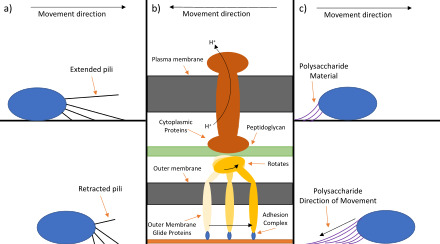Gliding motility is a type of translocation used by microorganisms that is independent of propulsive structures such as flagella, pili, and fimbriae.[1] Gliding allows microorganisms to travel along the surface of low aqueous films. The mechanisms of this motility are only partially known.
Twitching motility also allows microorganisms to travel along a surface, but this type of movement is jerky and uses pili as its means of transport. Bacterial gliding is a type of gliding motility that can also use pili for propulsion.
The speed of gliding varies between organisms, and the reversal of direction is seemingly regulated by some sort of internal clock.[2] For example the apicomplexans are able to travel at fast rates between 1–10 μm/s. In contrast Myxococcus xanthus bacteria glide at a rate of 0.08 μm/s.[3][4]

a) type IV pili, b) Specific motility membrane proteins, c) Polysaccharide jet
Cell-invasion and gliding motility have TRAP (thrombospondin-related anonymous protein), a surface protein, as a common molecular basis that is both essential for infection and locomotion of the invasive apicomplexan parasite.[5] Micronemes are secretory organelles on the apical surface of the apicomplexans used for gliding motility.
In the diagram above, right:
| a) | type IV pili |
| A cell attaches its pili to a surface or object in the direction it is traveling. The proteins in the pili are then broken down to shrink the pili pulling the cell closer to the surface or object that was it was attached to.[6] | |
| b) | Specific motility membrane proteins |
| Transmembrane proteins are attached to the host surface. This adhesion complex can either be specific to a certain type of surface like a certain cell type or generic for any solid surface. Motor proteins attached to an inner membrane force the movement of the internal cell structures in relation to the transmembrane proteins creating net movement.[7] This is driven by the proton motive force.[8] The proteins involved differ between species. An example of a bacterium that uses this mechanism would be Flavobacterium. This mechanism is still being studied and is not well understood.[9] | |
| c) | Polysaccharide jet |
| The cell releases a 'jet' of polysaccharide material behind it propelling it forward. This polysaccharide material is left behind.[10] |
- ^ Nan, Beiyan (February 2017). "Bacterial gliding motility: Rolling out a consensus model". Current Biology. 27 (4): R154–R156. doi:10.1016/j.cub.2016.12.035. PMID 28222296.
- ^ Nan, Beiyan; McBride, Mark J.; Chen, Jing; Zusman, David R.; Oster, George (February 2014). "Bacteria that glide with helical tracks". Current Biology. 24 (4): 169–174. doi:10.1016/j.cub.2013.12.034. PMC 3964879. PMID 24556443.
- ^ Sibley, L. David; Håkansson, Sebastian; Carruthers, Vern B. (1998-01-01). "Gliding motility: An efficient mechanism for cell penetration". Current Biology. 8 (1): R12–R14. doi:10.1016/S0960-9822(98)70008-9. PMID 9427622.
- ^ Sibley, L.D.I. (October 2010). "How apicomplexan parasites move in and out of cells". Current Opinion in Biotechnology. 21 (5): 592–8. doi:10.1016/j.copbio.2010.05.009. PMC 2947570. PMID 20580218.
- ^ Sultan, Ali A.; Thathy, Vandana; Frevert, Ute; Robson, Kathryn J.H.; Crisanti, Andrea; Nussenzweig, Victor; Nussenzweig, Ruth S.; Ménard, Robert (1997). "TRAP is necessary for gliding motility and infectivity of plasmodium sporozoites". Cell. 90 (3): 511–522. doi:10.1016/s0092-8674(00)80511-5. PMID 9267031.
- ^ Strom, M.S.; Lory, S. (1993-10-01). "Structure-function and Biogenesis of the Type IV Pili". Annual Review of Microbiology. 47 (1): 565–596. doi:10.1146/annurev.mi.47.100193.003025. ISSN 0066-4227. PMID 7903032.
- ^ McBride, Mark J. (2001-10-01). "Bacterial gliding motility: Multiple mechanisms for cell movement over surfaces". Annual Review of Microbiology. 55 (1): 49–75. doi:10.1146/annurev.micro.55.1.49. ISSN 0066-4227. PMID 11544349.
- ^ Dzink-Fox, J.L.; Leadbetter, E.R.; Godchaux, W. (December 1997). "Acetate acts as a protonophore and differentially affects bead movement and cell migration of the gliding bacterium Cytophaga johnsonae (Flavobacterium johnsoniae)". Microbiology. 143 (12): 3693–3701. doi:10.1099/00221287-143-12-3693. ISSN 1350-0872. PMID 9421895.
- ^ Braun, Timothy F.; Khubbar, Manjeet K.; Saffarini, Daad A.; McBride, Mark J. (September 2005). "Flavobacterium johnsoniae Gliding Motility Genes Identified by mariner Mutagenesis". Journal of Bacteriology. 187 (20): 6943–6952. doi:10.1128/JB.187.20.6943-6952.2005. ISSN 0021-9193. PMC 1251627. PMID 16199564.
- ^ Hoiczyk, E.; Baumeister, W. (1998-10-22). "The junctional pore complex, a prokaryotic secretion organelle, is the molecular motor underlying gliding motility in cyanobacteria". Current Biology. 8 (21): 1161–1168. doi:10.1016/s0960-9822(07)00487-3. ISSN 0960-9822. PMID 9799733.